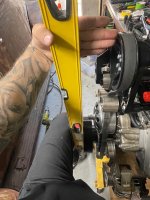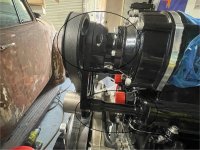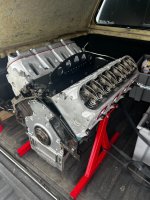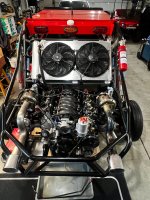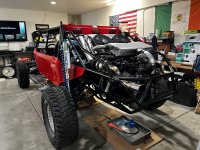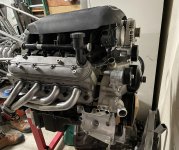Jason
Last time I will post on this thread, but when you call me a liar I cannot just sit back.. so here it goes - If no one wnats to read it - they can scroll down - I just like to help educate when I can
My goal is always I just want to give people information to help them make good decisions - just like you hopefully want - but you are not stating facts in this case ... you just want to sell engine jobs and sell blocks so you are distorting the facts to make your case and thats fine - more power to you everyone has to make a living
But then You act like like a can I say it "far left liberaL " - You cannot stand discussion and criticize writing a book then you write a book to complain -
I am not selling engine jobs or engine parts (although I do sell sand car parts) so I am relating what I know is best IMO and combined experience from some trusted builders and machine shops I use that fix those RHS block for some big builders - but everyone's experiences can differ - what cannot differ is common sense - while its no so common, I try to apply it when giving an opinion and I always state its IMO when it is
Now, admittedly I sell Holley EFI and I am biased on that but I state my Bias and the fact I liked Holley EFI way before I sold it
You complain about opinion then post a bunch of opinions - I don't see fact just opinion and incorrect statements on CP - at least get the facts correct or its not helping anyone
I never said CP is better than RHS, just that RHS is not right in every case
I guess from your comments you never touched a CP block and not have you spent anytime with the guys there either in person or on the phone - you must just be reading internet descriptions on the forums - the real keyboard warrior experts (like us)
I have used both RHS and CP Performance and prefer them for different applications - I will use either - except Like I said I won't use RHS anymore on SC cars anymore with big SC's
In fact I don't use big Whipples anymore they are too hard on the crank and take too much HP compared to smaller SC at same boost level on certain engines - bigger is not always better - you can make same HP with their smaller 3.0 or the bigger Eaton up to 1000HP or the KB 3.6 and give up so much - so net HP is way up
but thats off the subject -
Back to RHS - Prior to comp group VC's taking over RHS thats all I ever used aftermarket, but not anymore - I have choices and don't have to deal with their availability issues and price gouging - now that is opinion
-----
Anyway just so people can see for themselves: I will address your list of features for the RHS and the List for CP in comparison...
RHS features, - these are features - Not always benefits - there is a difference.,.. we have cars that are More like street cars than Drag cars - and mosr of the Features are good on drag or pure race cars and have no benefit to us except making the build less standard
- NO Rear Barbell, it has plugs with large rear oil passage - this has no real benefit in a Non race car that you are using without a thermostat on the oil - LSX can make 3500HP on the block -oiling is fine - barbell jst redirects flow of oil keeping clean and dirty separate - they never fail and there is more than enough oil flow on an LS - this is ok on erace car for the feature you list below to be enabled
- Rear Outlet 12AN built into the rear of the block for full flow oil and oil cooler or dry sump return - this is nice for a pure drag race environment but actually a PIA when you want to use an oil thermostat like you absolutely should use a on a sand car - you have to buy an inline thermostat, expensive and hard to plumb - millions of thermostats are made for standard LS engines - work great save $$ - again LSX oiling is good for 3500HP - nice to have for a dedicated race car - 12 is also over kill unless you are running a huge Dry sump tank ( like 16 quarts - 4 gallons)
- Billet rear cover with inverted pyramid slot to hold o-ring, this is better than the standard o ring straight channel, - thats called an opinion - why is it better than what GM did that works perfectly - I can go either way on this - its probably easier to install O-ring maybe - I never noticed a difference GM oil ring is fine after you do a bunch of them.
- upper valley is setup for knock sensors - we don't use knock sensors in sand cars 99% of the time - and when we do we use LS3 style side of block - no benefit - its just a leftover since this block was designed back when LS1's were the only engines so they copied what GM did - GM got rid of that with later engines and went to side knock sensors
- Larger lifter area, they deleted the LSX style try design putting more meat in the block over the 6mm bosses for trays, - CP eliminated the Lifter trays too and CP put in X-bracing so its stronger but it makes using 6 bolt heads a little harder toi tight the bolts underneath - I like that RHS feature a little better for that reason
- can run rear cam sensor, again a leftover feature because thew block was designed 20+ years ago -- it was designed back when LS1's were the only engines so they copied what GM did - GM got rid of that with later engines because its not needed or preferred - 4x timing on the front cover is more accurate
- steel or brass cam plate -I guess its nice to have a brass cam plate- I am not sure why I would need one. Both the CP and RHS blocks have provision for raised cam ( to clear big strokes and big rods - so they both have new cam plates different than factory LS block - CP uses a ground flat steel plate
- STANDARD, ARP 7/16 main studs, everyone the LSX and CP use 10mm, - CP uses 7/16 or 1/2" ARP studs with deep setting - this was made possible by the extra beef in the block helps not to pull the front main out of the block - I order all with 1/2" Mains and 1/2" head studs - no cost option - strong as can be
- Cam Bearings come installed - this is a not a benefit IMO Anyone that blueprints the engine before putting it together will remove them - can't completely cleanthe block correctly with cam bearings in after all the machine work and deburring - I clean up the cam passages too - so the bearings have to be out. I knock them out before machine work so thay don;'t get damaged anyway and leave them out to clean the block after machine work - this is the right way to do it most builders would agree
- Comes with Spiral locks for cam bearings - thats nice to have - we have seen cam bearings be problems in the past on stock GM engines - again a throwback to old LS1 issues- and probably why they istall the bearings spiral locks can be difficult to install correctly in the shop
- Side bolts 3/8 ARP, all other are 8mm - CP has dual 8mm - - larger cross sectional area - I like that bettter more surface area and larger spread on the force - but can go either way By The way they supplied GM side bolts I swap for ARP as a best practice
CP Features -
All of the Above plus:
• You can call them and talk to the owner - he will answer all your questions - In comparison RHS is owned by Industrial Opportunity Partners (IOP), an operations-focused private equity firm based in Evanston, Illinois, and owner of Edelbrock LLC. they have 1,000 employees and are mostly focused on cutting lower volume products and reducing cost of products, not innovating products ( read their latest 10K it says that almost verbatim)
• They own the foundry and specialize in aluminum production - with a history in Aerospace
Reinforced LSX design - everything is stronger - its NOT just an LSX copy
*Added cross bracing in the lifter valley
*Maximized crankshaft saddle radius and a 40% larger footprint from our double crossbolted main caps (thats the 2 x 8mm side bolts) - crank stability allows more HP and improves Bearing life under high load
• Tall deck raised cam can handle a 4.600 stroke
thats my take
thank you members for indulging me

